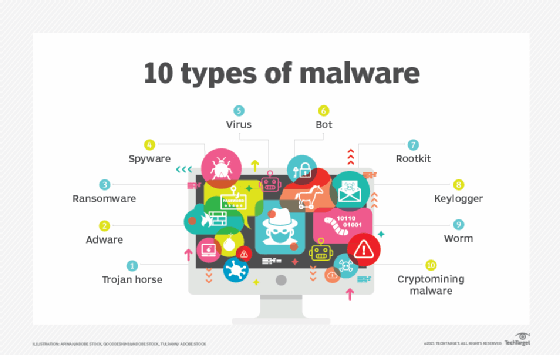7 common file sharing security risks (original) (raw)
IT administrators must understand the top file sharing security risks and what to do to ensure they don't create vulnerabilities for the broader organization.
File sharing is one of the most common activities of daily life online, but if users aren't careful, it can expose them and their organizations to a wide range of security risks.
Whether a single image or a complex computer program, file sharing underpins our professional, consumer and personal lives on the internet. This pervasiveness creates several potential attack vectors for anyone with malicious intent. The best defense starts with an awareness of the possible threats.
Explore the seven most common file sharing security risks and the key considerations users and IT administrators should keep in mind to mitigate danger.
1. Malware
File sharing can enable bad actors to install or bundle viruses, worms, spyware, Trojan Horses or other malicious code into files. This is somewhat more common in peer-to-peer (P2P) networks, where it is more difficult to verify if the source of a file is trustworthy, but the risk can still penetrate organizations. If an employee opens a file containing malware on an enterprise network, that can expose the broader network to attack.
Mitigate this threat by understanding how to recognize malware and raise awareness of related social engineering threats such as phishing or offers for free software. With the rapidly changing nature of attacks, the risks of malware are always evolving, so it's also critical to ensure that all devices and networks have the latest security updates.

Unsecured file sharing can open a computer or network to several types of malicious code.
2. Sensitive and prohibited content
Whether intentionally or not, exposing sensitive data via file sharing can have dangerous consequences, which can go unnoticed long after the breach. Sensitive and proprietary information within an organization, such as competitive product plans or financial data, can easily become vulnerable.
The essential mitigation against this threat is for everyone to exercise great vigilance and discretion in what they share. Organizations should invest in training all employees on distinguishing and safeguarding sensitive information and implement policies for sharing with external parties. IT can also implement strict access privileges on the back end that limits read and write access, so even if a file or folder is accidentally shared, it can't be accessed.
Protecting personal data and information as part of file sharing is an extension of general data privacy best practices.
3. Personal data and information
An individual's personally identifiable information (PII) comes in many forms, such as biometric data, geolocation and behavioral data. If the wrong parties access it, PII can expose people to terrible consequences, including identity theft and financial or reputational harm. In personal and sensitive data cases, it's often very difficult to know how far it's spread once unauthorized parties have gained access.
Protecting personal data as part of file sharing is an extension of general data privacy best practices. Along with practicing vigilance, strong passwords and authentication, IT should ensure that file sharing services encrypt data and protect encryption keys. Additionally, IT should set defaults to restrict access and require reauthentication. When designing user experiences, don't be afraid to temper "ease of use" with security friction.
4. Approvals, controls and access
Sharing is inherently a two-way or multi-way street, and several file sharing security risks arise around who or what is involved. For example, do employees rely on enterprise-grade or unapproved, consumer-grade file sharing tools? Shadow IT, in which employees use tools unbeknownst to the IT department for business processes, limits visibility and risks information loss through file sharing. Are recipients verified before sharing? It is always possible that the device or network of one of the parties is compromised, and an unauthorized agent could have intercepted information while files were in transit.
Safeguarding against these kinds of threats requires a wide-angle view, sometimes called ecosystem security. This means incorporating security tactics and defense across the entire landscape of the organization, including, but not limited to, the following:
- identity access management (i.e., credentialing, permissioning, authentication, mapping);
- asset inventories (i.e., software programs, computers, devices, IT/OT/IoT, endpoint, remote work and BYOD infrastructure);
- security orchestration (i.e., analysis, response and automation of updates, certificates, patches and traffic patterns); and
- third-party risk management (i.e., vendor evaluation, compliance adherence, app marketplaces, APIs, data lifecycle management).
5. Disabling firewalls
Some file sharing services require disabling or bypassing firewalls to upload or download files. While momentarily opening a firewall port may seem benign, it risks the chance of hackers accessing the device or network, a distributed denial-of-service attack, and other penetrations. For instance, man-in-the-middle attacks happen when an attacker gets between two parties that think they are communicating directly.
Ensure that firewalls are installed and always enabled. In addition to reducing the risks outlined above, firewalls also help block unwanted network traffic, reducing the likelihood that someone could install malware or malicious code.
6. Susceptibility and supply chain attacks
While file sharing security risks often affect individuals, they can also be a vector for third-party or supply chain attacks. Distinct from an attack that directly targets an individual node, such as an executive's email account or the IT admin's device, this kind of susceptibility refers to when a malicious actor infiltrates the organization by penetrating third parties that provide services to it. If the attack successfully embeds malicious code or malware into a third party's services, it's more likely to exploit more victims, namely the third party's customers.
In addition to the best practices mentioned for other file sharing security risks, organizations should collaborate with their employees to forge a security-minded culture. Invite mutual risk assessments where partners openly participate in risk mitigations and proactive measures. Develop communications and knowledge sharing among security analysts from multiple sources to know the latest best practices. And finally, an organization can limit the potential fallout from a cyber attack by not relying on a single vendor for all mission-critical services.
7. Prosecution
Files don't have to be infected with malware to wreak havoc. They could also include content with major legal ramifications for downloading, such as copyrighted materials or pirated software. Data sensitivity and privacy are also relevant here, considering the growing number of data regulatory policies such as the General Data Protection Regulation, the California Consumer Privacy Act and countless other data protection laws. Who is liable if customer information or intellectual property is exposed via file sharing? Without visibility into data flows, organizations cannot adequately monitor files and ensure compliance with internal policies or with external mandates and agreements. A lack of visibility also raises risks of penalties, fines and threats to company credibility.
Though these risks are far more likely on unregulated P2P file sharing applications versus an enterprise-grade system, they speak to the role file sharing can play amidst broader and rapidly evolving legal questions in the digital age.
The most direct way to avoid potential legal threats is to ensure that the file sharing service offers strong security and encryption. Key features include access controls, expiring file access, and e-discovery and statements for compliance reporting.
The capabilities and convenience of file sharing create countless advantages and accelerate collaboration and innovation in the digital era. But organizations can't overlook potential file sharing security risks. Mitigating the threat is about following best practices, taking an ecosystem-wide inventory and ensuring the chosen file sharing tool emphasizes security.
 Can a virtual machine infect its host with a virus?
Can a virtual machine infect its host with a virus?  By: Helen Searle-Jones
By: Helen Searle-Jones  By: Kevin Beaver
By: Kevin Beaver  How to avoid malware on Linux systems
How to avoid malware on Linux systems  By: Jack Wallen
By: Jack Wallen